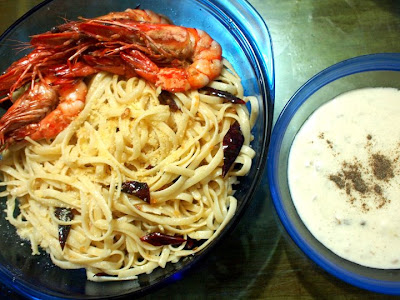Shopping for the Safest Cookware
* by Toby Amidor in Food Safety – Posted Wednesday, October 14, 2009, 2:30 pm
source: http://blog.healthyeats.com/blog/2009/10/14/choosing-the-safest-cookware/
After I served up rice with flecks of metal, my hubby finally agreed we needed new pots and pans. I got the All-Clad ones I’ve always wanted. After six years, my set is still going strong and dinner has been fleck-free ever since. If you’re looking to upgrade or just wondering about your everyday pots, here are some important things to know.

Aluminum
More than half the cookware sold today is made of aluminum. These pieces are usually coated with a nonstick finish or treated to harden the surface and make it scratch-resistant. If you have an old non-coated aluminum pot or pan, chances are it will start showing wear sooner or later (this is known as “pitting”); you might start chowing on metal flecks, too. If you keep cooking with it, this can add too much aluminum to your food, a potentially toxic situation.
A warning: If you use aluminum cookware, don’t store acidic foods — lemon juice, tomato sauce, oranges vinegar, etc. — in it. Extended exposure to acidic dishes can leach more aluminum into your food. If you’re prepping soups, sauces or other longer-cooking recipes that contain acidic ingredients, choose anodized aluminum cookware. Anodization is a process that hardens the surface of the cookware, making it non-stick, scratch-resistant and easy to clean.
Our Pick: Infused Cookware set by Calphalon

Stainless Steel
Made from a combo of iron and other metals, this go-to metal is durable and won’t corrode or tarnish. Some stainless steel contains chromium and may also have nickel, molybdenum or titanium, which boost its resistance to damage from high temperatures and scratching.
Because stainless steel doesn’t conduct heat evenly, most pots and pans have copper or aluminum bottoms. Like with aluminum pots, don’t keep your acidic or salty foods in stainless steel cookware for long periods or you risk damaging them.
Lots of home chefs prefer all-clad stainless steel. “Clad” means “three ply,” which consists of an aluminum or copper base layer sandwiched between layers of stainless steel so the heat is more evenly distributed. Although it’s pricey, my All-Clad set is worth it!
Our Pick: Stainless Steel Cookware by All-Clad

Copper
Copper is a great heat conductor and excellent for range-top cooking. Many cooks like to use it for delicate sauces and foods that need to reach exact temperatures. Copper cookware is typically lined with tin or stainless steel for safety; the FDA warns against using unlined copper pots since the metal easily leaches into acidic foods. If you’ve been cooking with unlined pots, go to your doctor if you suspect you’ve overloaded on copper — symptoms include nausea, vomiting and diarrhea.
Our Pick: Try-Ply Copper by Calphalon

Iron
Cast iron is strong, inexpensive and evenly conducts heat — this makes it good for browning, frying and baking foods. Cooking with these heavy pots and pans leaches iron into your food, which, in this case, is a good thing. Using unglazed cast iron typically adds about twice the amount of iron. You don’t want to store your food in this cookware, but cooking with it once or twice a week can be a nice iron supplement to your diet (especially for those with iron-deficiency anemia).
Our Pick: Cast iron skillet by Lodge

Enamelware
Some aluminum, iron and steel has an enamel coat, which makes it stain and scratch resistant. It also doesn’t pick up food odors. In the 1970s, the FDA detected that enamel cookware might cause cadmium toxicity — after that, the U.S. banned these products. These days, you’ll find cadmium-free enamelware available. The FDA continues to test cookware to make sure we’re not exposed to excessive metals while using them.
Our Pick: Enameled Dutch Oven by Le Creuset
Nonstick Pans
While convenient for cleaning, many nonstick coatings wear away with hard use — you may even get pieces that chip off. The FDA claims that these particles don’t pose a health hazards. Research has also suggested that heating coated pans for long periods of time at high temperatures leads to off-gassing potentially toxic fumes, which has scared some away from nonstick. From what I’ve found, these fumes are less toxic than those given off by ordinary cooking oils.
Our Suggestion: Don’t overheat your nonstick cookware and only use appropriate utensils with them (no metal spatulas or spoons, which can damage the surface). Replace them when you notice scratching or the nonstick coating is chipping off.

Utensils
What you cook with affects your pots and pans, too. Metal tools can damage even the nicest cookware, but don’t turn to the cheap plastic utensils either — they’ll melt right into your meal. Use wood spoons and silicon spatulas to preserve your pots and keep food safe.
Our Pick: Slotter Turner by Henckels

















